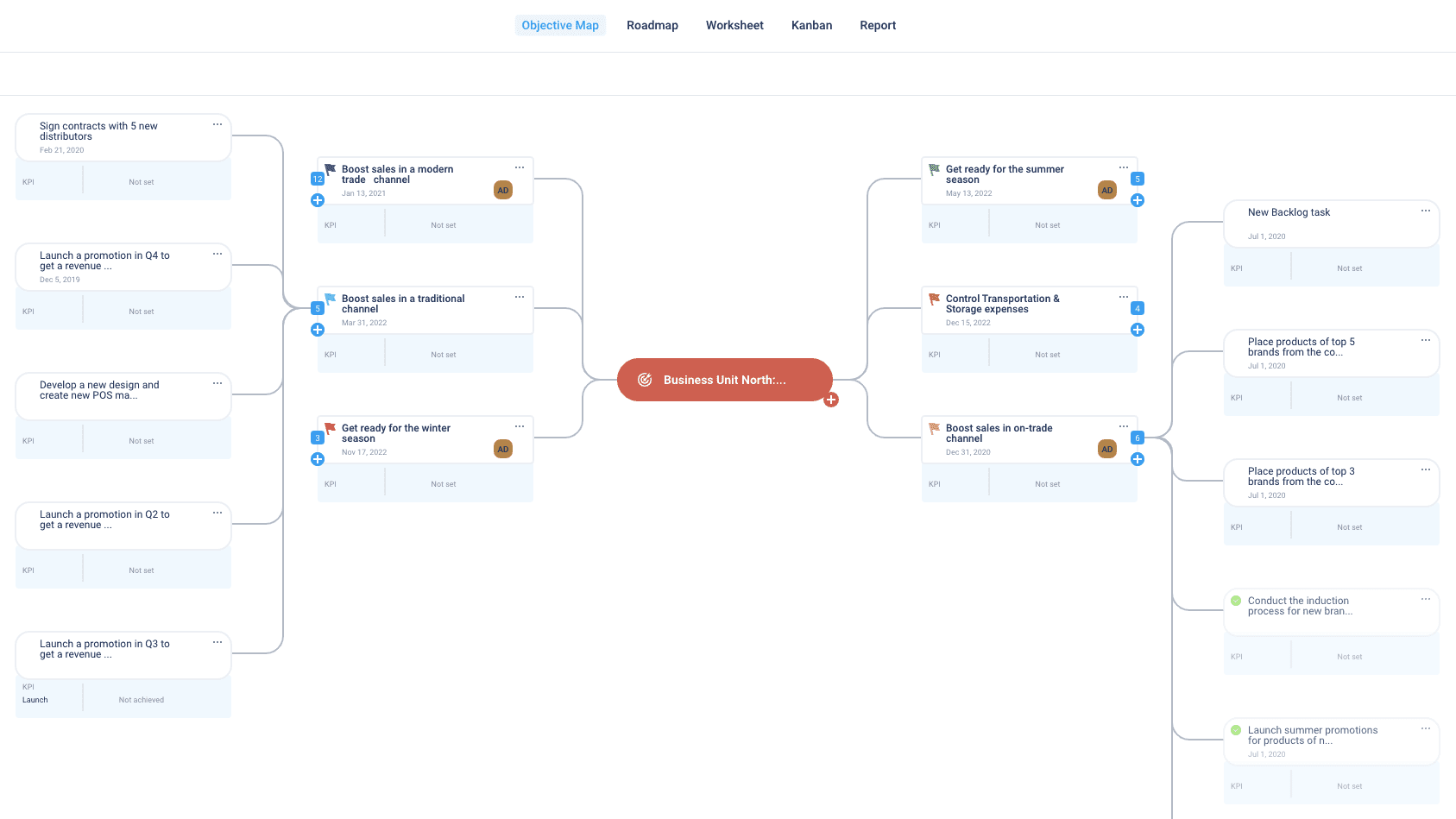I don't agree with mathematics. The sum total of zeros is a frightening figure.
Stanislav Jerzy Lec
How Not to Harm and Benefit
Literally, after the start of the KPI expansion in business, two discussions unfolded: support for the widespread use of KPI in business, and criticism of the widespread use of target metrics that point out significant problems with this approach. In particular, the most obvious issue of this approach is that the most essential factors are still impossible to measure. For example, it is difficult to digitize the true team spirit and desire of the team to cooperate for achieving goals. Let's figure this out.
They started talking about KPI after the works of Peter Drucker, a consulting guru who formulated the principles of the Management by Objectives. Though Drucker remains an outstanding business consultant, business experts believe that since the time of Drucker, the practice of management has only stepped back. So on the cover of Forbes magazine in 1997 (Druker was 88 years old), there was a photo of Drucker accompanied by the caption: Still the Youngest Mind.

Drucker wanted to create a simple method that could help bosses achieve their long-term objectives:
- “What the organization wants to achieve”
- “What are our tasks in this regard”
In his book “The Practice of Management” (1954), the main principles of the Management by Objectives (MBO) approach were developed:
- The team focuses not on doing the work as such, but on achieving the result.
- Before embarking on a particular task, an effective leader wonders: “What results are expected of me?”
- Goals are developed not only for the organization but also for each of its employees.
- The goals of the employees should be related to the goals of the organization
- Goals don't just come down from above, they are developed by the manager and the performer in collaboration and constant communication.
Peter Drucker also emphasized that during the discussion, answers to the following questions should be found:
- What needs to be known to solve the problem?
- What needs to be created to solve it?
- What needs to be organized in the process of solving the problem?
In search of answers, both the leader and the subordinate begin to better understand all the whats and hows.
- Working communication on the Objective is constant and as fast as possible.
- All goals must comply with the "SMART" principle.
- The company forms goals, then the goals are written down by periods for departments, after which short-term Objectives are distributed among employees.
Criticism of KPI

One should well understand and distinguish the rhythm of blossoming and the rhythm of fading away.
Miyamoto Musashi
There are severe criticisms about this method. KPI is the fruit of mistrust of some managers toward others. The former does not understand what the latter is doing and wants to keep the work of their subordinates under control. But it is too difficult to do this by delving into the work of their subordinates, so they invent formal methods for converting the results into a unified corporate currency - KPI points.
Needless to say, the creator of this method, Peter Drucker, offers a method of Management by Objectives that is something fundamentally different.
What is usually on the agenda of modern managers - “Where can we get good numbers that we will show shareholders at the right time?”. And this is not about breakthrough ideas, this is about looking at indicators - how good everything looks.
There are three ways to achieve goals:
- To manipulate numbers. This is when outsourced police dispatchers made 999 calls during “quiet” hours to achieve their goal, and doctors switched from treating seriously ill patients to those with minor problems to achieve the goal of reducing “time-solving the patient's problem” up to 4 hours.
- To manipulate the system that gives these numbers. Cut the cost of an overhaul to increase EBITA, or call the shipment of goods like sales (example from FMCG).
- To improve the system and the processes that give these numbers. It is the most unpopular method, but at the same time, the only healthy and truly working one.
It is believed that once Drucker was talking with another business guru, Edward Deming. Drucker found out how his approach is used in management and was very disappointed.
Now it's hard to believe, but MBO (Management by Objectives) was created for the development of business and the team due to a special attitude to problems. Namely, the goals allow you to figure out your limits, which you cannot go beyond yet. You need to change something in business, resources, and yourself. These restrictions and limits are the objectives of your “hunt”. Working with them allows you to increase your potential, which makes it possible to cope with more complex goals. This is the essence and purpose of using KPIs.
To achieve a result (make deep changes), you need to answer the following questions:
- What needs to be known to solve the problem?
- What needs to be created to solve it?
- What needs to be organized in the problem-solving process?
KPI Lifehacks
There are difficult moments in working with KPIs. We propose to discuss some of them.
KPIs do not show but simplify reality

It is important to understand that any description of reality, and a tree of Objectives built on the hypothesis of cause-and-effect relationships, is primarily a model. The relationship between reality and the KPI system is the same as between the map and the territory. A map is always a simplification.
Maps are almost always useful, but they are not reality. There is a story about how a combat unit during the fighting was able to get into friendly territory using a map ... as it turned out - a map of a completely different area. The meaning of this story is that our thinking is also essentially a map, it is a familiar tool for us with which we try to manage our affairs.
But responsible management professionals do not make one important mistake - they do not equate numbers with facts!
Coordination of Objectives KPI
Let’s consider two goals: Doing more and doing more efficiently. They are rather antagonistic, aren’t they? The requirement to sell more usually leads to a disproportionate increase in marketing costs and an increase in future losses (for example, due to returns of defective goods). Selling more efficiently means finding the optimal connection between the marginal utility of marketing spend and revenue generated.
Now imagine a company where the team has both Objectives because some managers consider them to be bound without any contradiction.
There are many such examples. Developing a tree of Objectives is quite a difficult task if the team is going to achieve them. The Objectives should be consistent and there should be no logical contradictions between them. The slightest difficulty arises when trying to reconcile short-term Objectives and long-term ones. The first one grabs the manager’s attention because bonuses depend on them. The second one has no impact in the current period, but the consequences of damage to these Objectives can cost the company its life.
To better understand this topic, we recommend studying the work of the remarkable economist Frederic Bastia and his book “That Which Is Seen and That Which Is Not Seen”.
N.B. They also say that efficiency is doing things right; effectiveness is doing the right things. Initially, these are unrelated goals.
KPI = Micromanagement

This is not necessarily the case, but when it is, it becomes a problem.
There is a lot of talk about micromanaging, and usually bad. There is a theory of Self-determination that affirms the principles of an effective and healthy personality:
This approach provides a human to become self-determined when his needs for 1) competence, 2) connection, and 3) autonomy are fulfilled.
- Autonomy: A person needs to have control over his manners and objectives. This feeling makes a human feel his role in real life and allows them to have a sense of influence on the circumstances around him.
- Competence: A person needs to improve his skills and obtain new knowledge. When a person realizes that he has enough skills to succeed in any task, he will try his best to achieve the Objectives.
- Kinship or connection: A person always needs a sense of belonging to other people.
Micromanagement based on blindly following KPIs undermines all three theses of self-determination theory:
First, increased control over every step of the employees indicates a lack of faith in their ability to do their job well. Second, it reduces their sense of autonomy. Third, it destroys connection with other people because each person feels forced to focus only on the task at hand.
Treating people as machines destroys any potential for motivation and goes against the social nature of people.
KPI as a lagging metric
Objectives formalized in KPIs are the result of a chain of decisions. KPI is the final of some processes, i.e. lagging indicator. So to get a different result, we must change what preceded it. This is where the problem arises - the KPI itself does not say anything about this. Moreover, if the KPI is not achieved, usually no one knows exactly what the problem is.
Any KPI is a post-factum indicator of events that we can influence only if we determine the causes - factors preceding the selected metric.
Part and whole
Another difficulty lies with the method itself, which is used to manage the team through KPIs.
A common KPI for the team allows you to introduce a clear evaluation criterion, but problems can arise within the team, because. It is not clear who and to what extent can influence the result.
Split KPIs for all participants in the process - paradoxes are possible here - personal KPIs are met, but the result is not achieved. There can be many reasons for this.
Proper use of KPIs is based on the same principles that evolution is based on:
- not the one who is stronger/higher/throws further wins
- those who know how to cooperate/unite around common Objectives win
- the whole is not equal to the sum of the parts
- the whole gets new qualities that help each part of the organization learn something new, go beyond its boundaries, and become more perfect
Conclusion

Peter Drucker already once gave very precise recommendations about the use of KPIs. A potentially powerful method has been bled dry by misunderstanding and misapplication. A purely technical application of KPI: “bonus for the objective” - missed the whole essence of the method from the field of attention.
The application of KPIs gets into a quandary when they are used as a tool in organizations where people are viewed simply as objects - means to other ends - and not as subjects with their own Objectives.
Best of all, the true essence of the method can be expressed by the following ideas:
- KPI is designed for active management. This means that instead of the usual behavior - a belated reaction to external changes, the team builds reality control through Objectives, doing everything necessary to achieve them.
- Psychologists conventionally divide people by type into “task people" who can perform small tasks that do not require drastic changes and transformations, and “result people”. KPI is about the last type.
- The team applying the KPI method is the offensive line in football. KPI is not about survival but development. The team learns to love finding and solving problems rather than manipulating the consequences.
- Objectives management is a tool for managing the company's potential associated with risks. Therefore, such a popular method of management by Objectives as OKR recommends not linking target metrics and monetary rewards. The point is to involve the team in the search for breakthrough techniques and innovations and not be afraid of risk.
- And an extremely important principle. Which of the resources in business is the most scarce? The usual answer is the time! But from the point of view of the result, time in itself means nothing. We know that different people can complete the same task in different period of time. This is due to their abilities, level of knowledge, etc. We can further develop this line of reasoning and find that at the top of the pyramid is such a thing as energy. The level of personal strength, and energy distinguishes people who, having taken on the same task, ultimately bring different results.
Drucker argued that the main task of management is to increase the energy in the organization!
Managing by objectives requires maturity from the individual, the habit of reflection, a deep analysis of cause-and-effect relationships, and a focus on resource development as the source of all victories.
KPI is the fruit of mistrust of some managers toward others. The former does not understand what the latter is doing and wants to keep the work of their subordinates under control. But it is too difficult for them to do this by delving into the work of their subordinates, so they invent formal methods for converting the results into a single corporate currency - KPI points.



